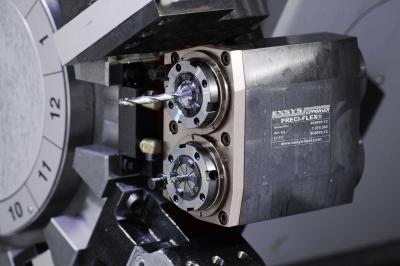
As a recent addition to its EPPINGER PRECI-FLEX modular tooling system, EXSYS Tool Inc. offers a two-collet chuck that doubles the machining capability of one turning machine tool turret station. Designed for Mazak QUICK TURN and QTU series turning centers with optional high-speed drive motors, Y-axis functionality and standard BMT turrets, the double-collet chuck can deliver speeds up to 10,000 rpm with a 1:1 ratio and 20 N-m of torque and features 1,000 psi, or 70 bar, internal coolant. In addition, 12,000-rpm live tool holders with a 1:1 ratio also are available.
With the double-collet chuck, shops can switch between fixed and rotary base holders with quick changeovers in one station on the machine turret, and mount any combination of two collets, endmill holders, expanding collet chucks and shrink fit tooling on a single base holder. For instance, a tap-and-drill or spot-and-drill combination becomes easy to set up for maximized equipment capability.
Available in Horizontal (H) type 90-degree radial holders and Vertical (V) type straight off-set axial holders, the PRECI-FLEX double-collet chuck provides repeatability within 5 microns. The tooling system features an EXSYS/EPPINGER compensating clutch with a floating coupling between turret drive motor tangs and toolholders that automatically compensates for misalignment. The resulting high precision reduces vibration and tool chatter for longer tool life and better surface finishes.
Manufactured by EPPINGER, the PRECI-FLEX modular system incorporates a conical and flat face planar interface that accepts either an adapter or a standard ER collet. The system offers unmatched flexibility, precision and cost savings, with an interface based on a well-known, universally used ER collet pocket configuration. The short, compact design with monoblock housing assures maximum torque transmission and rigidity, resulting in increased machining accuracy and improved productivity.
Contact Details
Related Glossary Terms
- centers
centers
Cone-shaped pins that support a workpiece by one or two ends during machining. The centers fit into holes drilled in the workpiece ends. Centers that turn with the workpiece are called “live” centers; those that do not are called “dead” centers.
- chatter
chatter
Condition of vibration involving the machine, workpiece and cutting tool. Once this condition arises, it is often self-sustaining until the problem is corrected. Chatter can be identified when lines or grooves appear at regular intervals in the workpiece. These lines or grooves are caused by the teeth of the cutter as they vibrate in and out of the workpiece and their spacing depends on the frequency of vibration.
- chuck
chuck
Workholding device that affixes to a mill, lathe or drill-press spindle. It holds a tool or workpiece by one end, allowing it to be rotated. May also be fitted to the machine table to hold a workpiece. Two or more adjustable jaws actually hold the tool or part. May be actuated manually, pneumatically, hydraulically or electrically. See collet.
- collet
collet
Flexible-sided device that secures a tool or workpiece. Similar in function to a chuck, but can accommodate only a narrow size range. Typically provides greater gripping force and precision than a chuck. See chuck.
- coolant
coolant
Fluid that reduces temperature buildup at the tool/workpiece interface during machining. Normally takes the form of a liquid such as soluble or chemical mixtures (semisynthetic, synthetic) but can be pressurized air or other gas. Because of water’s ability to absorb great quantities of heat, it is widely used as a coolant and vehicle for various cutting compounds, with the water-to-compound ratio varying with the machining task. See cutting fluid; semisynthetic cutting fluid; soluble-oil cutting fluid; synthetic cutting fluid.
- endmill
endmill
Milling cutter held by its shank that cuts on its periphery and, if so configured, on its free end. Takes a variety of shapes (single- and double-end, roughing, ballnose and cup-end) and sizes (stub, medium, long and extra-long). Also comes with differing numbers of flutes.
- flat ( screw flat)
flat ( screw flat)
Flat surface machined into the shank of a cutting tool for enhanced holding of the tool.
- modular tooling
modular tooling
1. Tooling system comprised of standardized tools and toolholders. 2. Devices that allow rapid mounting and replacement of tools. Commonly used with carousel toolchangers and other computerized machining operations. See toolchanger; toolholder.
- turning
turning
Workpiece is held in a chuck, mounted on a face plate or secured between centers and rotated while a cutting tool, normally a single-point tool, is fed into it along its periphery or across its end or face. Takes the form of straight turning (cutting along the periphery of the workpiece); taper turning (creating a taper); step turning (turning different-size diameters on the same work); chamfering (beveling an edge or shoulder); facing (cutting on an end); turning threads (usually external but can be internal); roughing (high-volume metal removal); and finishing (final light cuts). Performed on lathes, turning centers, chucking machines, automatic screw machines and similar machines.
- turning machine
turning machine
Any machine that rotates a workpiece while feeding a cutting tool into it. See lathe.

